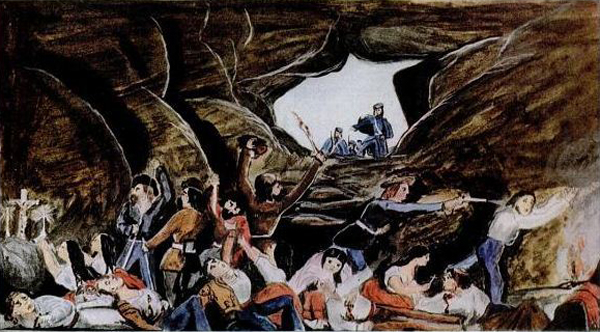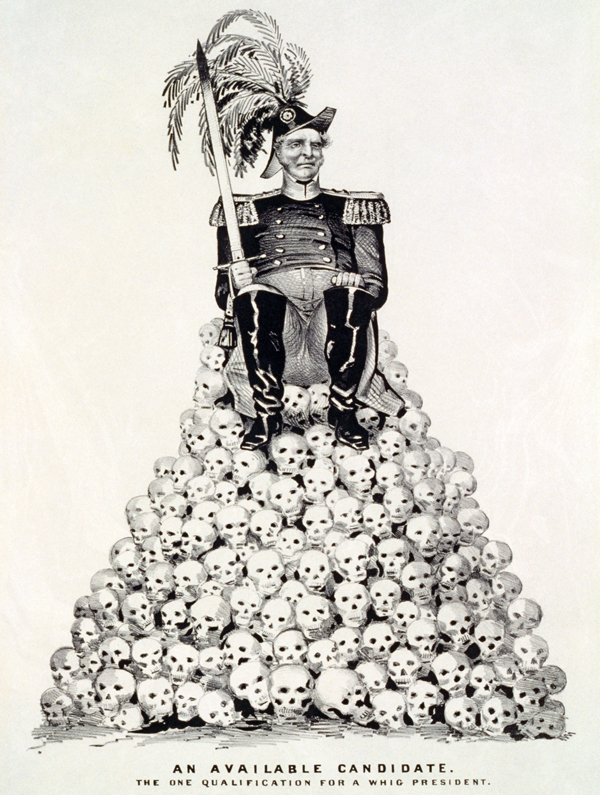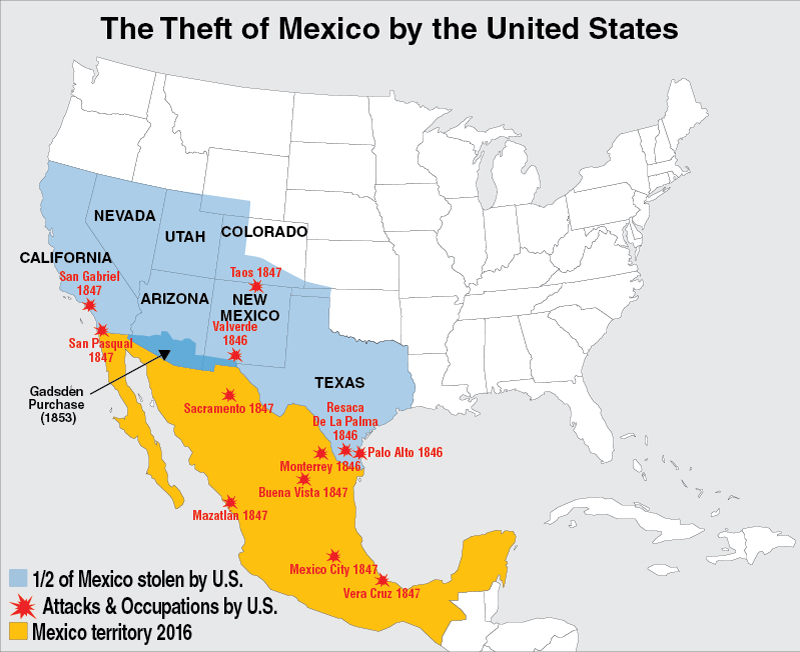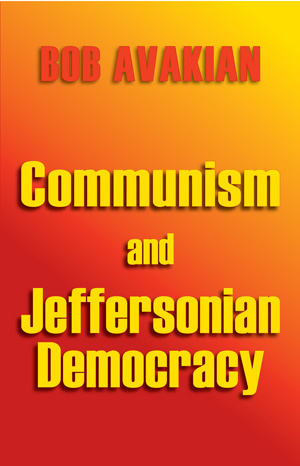Case #83: The U.S.-Mexico War of 1846-1848
August 30, 2016 | Revolution Newspaper | revcom.us
Bob Avakian has written that one of three things that has "to happen in order for there to be real and lasting change for the better: People have to fully confront the actual history of this country and its role in the world up to today, and the terrible consequences of this." (See "3 Things that have to happen in order for there to be real and lasting change for the better.")
In that light, and in that spirit, "American Crime" is a regular feature of revcom.us. Each installment will focus on one of the 100 worst crimes committed by the U.S. rulers—out of countless bloody crimes they have carried out against people around the world, from the founding of the U.S. to the present day.

Above: A massacre of Mexican civilians in a cave at Agua Nueva by American cavalry. One eyewitness wrote: "...The cave was full of volunteers, yelling like fiends, while on the rocky floor lay over twenty Mexicans, dead and dying in pools of blood, while women and children were clinging to the knees of the murderers and shrieking for mercy..."
Above (click map to enlarge): After the 1846 formal annexation of the slaveholding "Republic of Texas", U.S. armies invaded deep into Mexican territory from one end to the other. One half of Mexico was taken by the U.S. in the 1848 Treaty of Guadelupe Hidalgo that ended the war. Hundreds of thousands of Mexicans living in the stolen land were then subjected to conditions of poverty, exploitation and discrimination, which continues today.

The campaign for U.S. President in 1848 took place in the context of the predatory war by the U.S. against Mexico. The two major candidates vying for the nomination of the Whig Party were General Winfield Scott and General Zachary Taylor, both "heroes" who led assaults against Mexican cities and troops. The political cartoon above from 1848 depicts "the only qualification for a Whig president" to be how many people he murdered. (Image: Library of Congress)
THE CRIME: In the spring of 1846, U.S. President James Polk sent General Zachary Taylor and several thousand U.S. troops into what had been—before slaveholding settlers from the U.S. declared it an independent "Republic of Texas" in 1836—Mexican territory between the Nueces and Rio Grande Rivers, near the Gulf of Mexico, with the goal of provoking a war. When Taylor's troops arrived at the Mexican town of Matamoros on the Rio Grande and began menacing maneuvers, they were attacked by a force of Mexicans, just as Polk and his cabinet believed they would be. President Polk wasted no time in declaring Mexico guilty of aggression against the U.S.
On May 13, 1846, the United States Congress voted overwhelmingly to declare war on Mexico. And so began a war that resulted in the loss of tens of thousands of lives and the theft by the U.S. of more than half of Mexico's land.
After war was declared, General Taylor occupied Matamoros and U.S. soldiers carried out atrocities. When Taylor's army arrived in Monterrey, Mexico, west of Matamoros, a U.S. newspaper wrote: "As at Matamoros, murder, robbery, and rape were committed [by volunteer units of the U.S. Army that were closely tied to the slave-owning class in the U.S.] in the broad light of day, and as if desirous to signalize themselves at Monterrey by some new act of atrocity, they burned many of the thatched huts of the poor peasants. It is thought that one hundred of the inhabitants were murdered in cold blood, and one ... was shot to death at noon in the main street of the city."
U.S. reporters traveling with U.S. troops rarely wrote of these events, but some letters sent home by soldiers did. One Illinois army officer described a massacre by Arkansas volunteers. After one volunteer was killed by Mexicans in retribution for a raid on a ranch in Agua Nueva, where Arkansas volunteers robbed and raped the inhabitants, the Arkansas cavalry retaliated. They rounded up Mexican residents and herded them into a cave. The letter quoted a soldier who witnessed what happened:
The cave was full of volunteers, yelling like fiends, while on the rocky floor lay over twenty Mexicans, dead and dying in pools of blood, while women and children were clinging to the knees of the murderers and shrieking for mercy.
Shortly after war was declared, U.S. naval ships occupied the California port cities of San Pedro; Monterey, the Mexican capital of California; and Yerba Buena (later San Francisco). Other parts of California were also seized by U.S. forces. Mexican control of California ended.
As Taylor's army occupied the north, U.S. warships entered the port of the Gulf coast city of Veracruz in the south and laid siege to it, pummeling Veracruz for four days with 468,000 pounds of "shell and shot" until much of the city was in ruins. After this, General Winfield Scott's army landed and seized Veracruz, and then proceeded inland to Mexico City.
Scott's army entered Mexico City, the capital of Mexico, in September 1847. On February 2, 1848, the Treaty of Guadalupe Hidalgo was signed, ending the war. The U.S. grabbed millions of square miles of Mexico encompassing the states of California, Arizona, New Mexico, and parts of Utah, Nevada, Kansas, Oklahoma, and Colorado. Mexico suffered the crippling loss of 55 percent of its land and many Mexicans ended up on the U.S. side of the border where they faced humiliation, the theft of their land, and racist oppression.
THE CRIMINALS: Before running for president, James Polk, born to a wealthy slave-owning family and a slave owner himself, was a little-known politician. But he was backed in his bid for office by former president Andrew Jackson, a notorious slaver and butcher of Native American peoples, and an advocate for the expansion of slavery. Polk won the presidential election in 1844 and enthusiastically took up the cause of territorial expansion. The Polks brought their slaves to work in the White House.
General Taylor, sent to the Rio Grande valley to provoke war with Mexico, was also a slave owner who built up his military credentials in the wars of ethnic cleansing against the Black Hawk and Seminole native peoples.
General Scott oversaw the 1838 expulsion of 14,000 Cherokee from their lands in Georgia and other southeastern states, and their forced march to Oklahoma—the infamous "Trail of Tears" during which 4,000 Native people died of illness, starvation, and exposure.
Robert E. Lee, Jefferson Davis, and Stonewall Jackson were all U.S. military officers in the Mexican war, and were later major figures fighting for slavery and the Confederacy in the U.S. Civil War. And officers who ended up playing key roles in the U.S. Civil War on the side of the North were also officers in the U.S. army that invaded Mexico, including Ulysses S. Grant and George McClellan. As befit an army of slave owners, exploiters, and oppressors, the officers of the U.S. army all had servants, mostly Black people. Officers from the slave states, and even some from the "free" states, had slaves with them to do their bidding.
U.S. newspapers mainly lauded the war as a great, noble affair demonstrating U.S. superiority and the racial superiority of white Americans. They failed to report on the crimes carried out by U.S. troops. But there were abolitionists (anti-slavery groups) that opposed the war. One abolitionist paper, the Ashtabula Sentinel of Ohio, wrote, not "a hundredth part of the crimes committed by our troops are published, or ever come to the knowledge of our people."
THE ALIBI: President Polk falsely claimed that Mexico was the real aggressor. After he had sent troops to Mexican territory to provoke a conflict, Polk boldly lied, "After reiterated menaces, Mexico has passed the boundary of the United States, has invaded our territory and shed American blood upon the American soil." The New Orleans Bulletin wrote in a tone somewhat typical of the time, "The United States have borne more insult, abuse, insolence and injury, from Mexico, than one nation ever before endured from another.... They are left no alternative but to extort by arms, the respect and justice which Mexico refuses, to any treatment less harsh."
Major political figures, intellectuals, and U.S. media of the day promoted the concept of "Manifest Destiny," the idea that white Europeans were ordained by God to dominate the American continent and lord it over the "lesser races." Newspapers relentlessly portrayed Mexicans in ugly and racist ways. Journalists traveling with U.S. troops were quick to condemn Mexico's system of debt peonage but almost never mentioned the servants and slaves of U.S. officers unless, as often happened, they deserted to Mexico.
THE REAL MOTIVE: The war of conquest of Mexican land was the culmination of a decades-long effort to open up territory for the expansion of the slave system. White settlers seeking to expand slavery moved into Texas beginning in the 1820s. Mexico abolished slavery in 1829-30, and slave owners in Texas revolted and, in 1836, declared independence for the "Republic of Texas" in the Mexican province of Tejas. In 1845, the U.S. government formally annexed Texas, making it part of the United States.
The 1845 seizure and annexation of Texas from Mexico's poorly defended and lightly populated northern territories whetted the appetite of powerful groups of U.S. slaveholders and capitalists hungry to grab the land, riches, and the strategic position of Mexico's northern territories.
Powerful ruling groups supported the war against Mexico. They represented rival and exploitive modes of producing wealth. One mode was slavery, and the other was capitalism. The slave-owning class looked to Mexican lands to expand slavery and bring in new slave states to increase their political power. The capitalists eyed Mexican territory for its mineral resources and land. They also wanted West Coast ports for the great advantages it would give merchant capitalists in trade competition with England and France over China.
(In contrast to this, it is inspiring that during the war, between 175 and several hundred largely European immigrant soldiers deserted the U.S. Army and fought on Mexico's side. Called the Saint Patrick's Battalion, they're still honored in Mexico. By 1848 most had been captured and tried by the U.S. military. Some 50 were executed over several days—collectively the largest mass execution in U.S. history.)
REPEAT OFFENDERS: The Treaty of Guadalupe Hidalgo (1848) between Mexico and the U.S. ended the war. It promised constitutional rights to Mexicans in the Southwest of what was now U.S. territory, declaring they "shall be maintained and protected in the free enjoyment of their liberty and property." This treaty and a protocol guaranteed the Mexican people their land grants, language, and civil rights. In reality, the U.S. immediately began a process of seizing millions of acres of land that had been legally guaranteed to Mexican people, ultimately forcing hundreds of thousands into desperate conditions of poverty and exploitation, and subjecting them to outrageous discrimination by treating them as "foreigners" on the land that the U.S. had seized.
Sources:
Amy S. Greenberg, A Wicked War: Polk, Clay, Lincoln, and the 1846 U.S. Invasion of Mexico (Alfred A. Knopf, 2012)
Norman A. Graebner, Empire on the Pacific: A Study in American Continental Expansion(Regina Books 1983)
Juan Gonzales, Harvest of Empire: A History of Latinos in America (Viking Penguin 2000)
"Mexican Independence from Spain, and the U.S.-Mexican War," Revolution/revcom.us, May 20, 2007
Volunteers Needed... for revcom.us and Revolution
If you like this article, subscribe, donate to and sustain Revolution newspaper.











